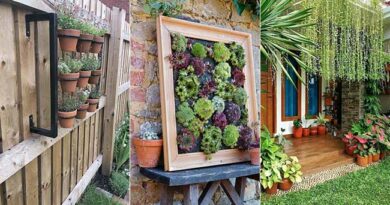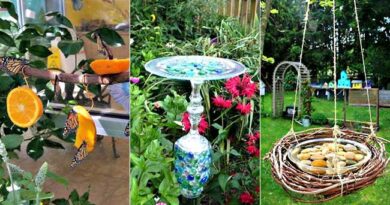Why Gardeners Hang Pinecones in Mesh Bags (It’s Not Decoration)
Why Gardeners Hang Pinecones in Mesh Bags (And Why I Started Doing It Too)

If you’ve ever wandered into an older gardener’s backyard and spotted pinecones hanging in little mesh bags, trust me, you’re not the first person to think, “Okay… what kind of forest magic is going on here?”
I used to think they were some sort of cute DIY decoration or maybe a bird toy gone wrong. Nope. Turns out, it’s one of those oddly smart garden tricks that make you go, “Of course. Nature figured it out before we did.”
Pinecones have been working for gardeners long before we had fancy moisture meters, weather apps, or those soil probes that beep like you’re searching for treasure. These things are basically tiny wooden weather stations that react instantly to moisture — and gardeners take full advantage of that.
Pinecones: The Original Moisture Meter
Here’s the cool part (and honestly the reason I tried this myself):
Pinecones open and close depending on the humidity. That’s their whole job in nature — protect seeds when it’s damp, release them when it’s dry. Simple and genius.
So when you hang one in the garden:
- Open pinecone → the air is dry → soil is likely drying too
- Closed cone → humidity is high → you might want to hold off on watering
It’s kinda wild how accurate this is. I once watered a bed right before a surprise rainstorm (because my weather app decided to lie to me again). The pinecone in my mesh bag had already closed tight. Lesson learned.
Why Mesh Bags? Because We’re Not Trying to Chase Rolling Pinecones
Mesh bags let the pinecones breathe while keeping them where you can actually see them. And they stay clean instead of turning into muddy rocks.
Plus:
- Air flows all around them
- They respond to moisture changes super fast
- Birds won’t steal them (learned this the fun way)
- You can move the bag anytime you want
Most gardeners hang one near vegetable beds, another by fruit trees, and maybe one near pots — because honestly, each corner of a garden has its own personality.
1. They Help Prevent Overwatering (The #1 Silent Plant Killer)
If I had a dollar for every plant I accidentally drowned, I could buy myself a greenhouse by now. Overwatering is way more deadly than underwatering.
Pinecones are like little “stop right there” alarms. When they close up, it usually means:
- humidity is high
- soil is holding extra moisture
- your plants don’t need more water (even if they look dramatic)
A tight pinecone reminds you to:
- skip watering
- check drainage
- let pots breathe a bit
- stop babying your plants to death
Especially helpful during rainy weeks when everything just stays soggy.
2. Pinecones Predict Rain (Better Than My Weather App)
This part almost feels like magic. Pinecones start closing hours before rain hits — even when the sky still looks harmless. It’s like they gossip with the clouds before the rest of us know what’s going on.
A quick glance tells you:
- half-closed cone → humidity rising
- fully closed → rain is basically on the doorstep
So gardeners use this to:
- delay watering
- bring seedlings inside
- avoid fertilizing right before a downpour
- set out rain barrels
I don’t trust my weather app anymore, but I trust my pinecones.
3. They Can Help Nudge Pests Away (Just a Little)
Now, pinecones aren’t going to patrol your garden like tiny wooden bodyguards, but they do release natural compounds — terpenes — that certain insects don’t like.
Not miracle-level, but helpful around:
- lettuce
- strawberries
- greenhouse doors
- seedling trays
They can bother ants, moths, and even slugs (slugs seem offended by everything, so that checks out).
It’s subtle, but for organic gardeners, every tiny advantage matters.
4. They Improve Airflow in Damp Spots
Hang a pinecone in a breezy corner and it moves just enough to keep air circulating. That gentle airflow helps prevent those damp, stale air pockets where mold and mildew love to throw parties.
Useful near:
- crowded tomato beds
- shady corners
- greenhouse edges
Think of it like cracking a window — small change, big difference.
5. They Tell Wildlife “Hey, This Garden Is Friendly”
I swear birds know when a space is wildlife-friendly. Pinecones send that signal loud and clear. Even if they aren’t dropping seeds, they feel… natural. Familiar.
And you’ll often see:
- seed-eating birds
- helpful beetles
- pollinators
- ladybugs
Just hanging around more. More wildlife = fewer bad bugs. Win-win.
6. They Absorb Extra Moisture in Damp Areas
Some parts of a garden stay damp no matter what — shady corners, spots near hoses, the awkward area behind your greenhouse where you pretend not to look.
Pinecones soak in extra moisture and slowly release it later when it’s dry. It’s like nature’s slow-release dehumidifier.
They’re great near:
- ferns
- raised beds with poor drainage
- patio corners
- anywhere moss keeps trying to claim territory
7. They Remind Gardeners to Pay Attention
Nobody likes to admit this, but we all get busy. A pinecone hanging at eye level is basically a gentle nudge:
- “Hey, I’m more closed today — something’s up.”
- “Look at the humidity, friend.”
- “Maybe check your soil before you panic-water that droopy plant.”
Gardening is 50% observation anyway. Pinecones just make it easier.
8. They Add That Rustic, Cozy Garden Vibe
Even if you don’t care about humidity, pinecones look good.
Hang a few near:
- trellises
- pergolas
- old wooden posts
- herb gardens
- little potting sheds
Suddenly your garden looks like something from a cottagecore Pinterest board — without trying too hard.
9. Pinecones Are Free, Eco-Friendly, and Practically Indestructible
Unlike moisture meters (which I break constantly):
- pinecones don’t need batteries
- don’t rust
- don’t cost anything
- don’t need replacing often
- don’t guilt-trip you with digital numbers
You literally pick them up from the ground, shake off the bugs, and you’re good to go.
10. They Help You Understand Your Garden’s Microclimates
This is the coolest long-term benefit. Every garden has little zones that act differently.
Hang pinecones in several spots and you’ll start noticing:
- where humidity lingers
- which beds dry out fastest
- where airflow gets trapped
- which corners heat up more
This kind of info takes most new gardeners years to figure out.
Pinecones make it obvious in a few weeks.
How to Use Pinecones in Your Own Garden
Here’s the simple setup:
Pick a mesh bag
The cheap produce bags from onions or oranges work great.
Choose a mature, dry pinecone
The wide-open ones react the fastest.
Hang it at about eye level
Somewhere you’ll actually see it every day.
Use more than one
Because your sunny tomato bed and your shady fern patch live totally different lives.
Replace only if they break
Which… rarely happens.
If you ever needed proof that nature already invented half the “smart garden gadgets” we buy today, this is it. Hanging pinecones is one of those small habits that quietly teaches you how your garden breathes, drinks, and reacts to weather — and honestly, it’s kinda fun watching them change.



